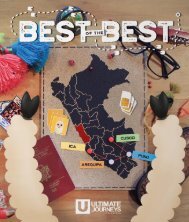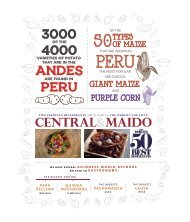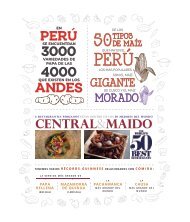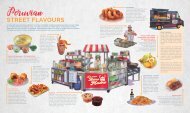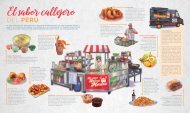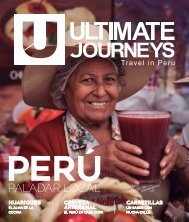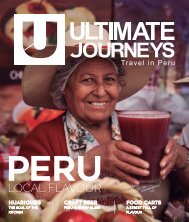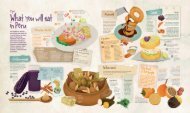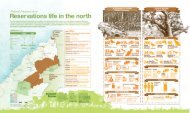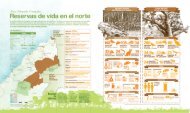UJ #3 - Peru: A luxury destination
You also want an ePaper? Increase the reach of your titles
YUMPU automatically turns print PDFs into web optimized ePapers that Google loves.
Moche Route<br />
CULTURAl-HISTORIC<br />
This tour focuses on four, major archeological<br />
sites. The first, the Huaca del Sol and Huaca<br />
de la Luna, are both part of a structural<br />
complex situated five kilometers south of<br />
Trujillo, the capital city of La Libertad. The<br />
Huaca del Sol is an adobe structure about 43<br />
meters high, which archeologists believe was<br />
used for administrative purposes. The huaca<br />
has a stepped pyramid structure and includes<br />
five large terraces, the largest of which is 80<br />
meters long. The Huaca de la Luna lies roughly<br />
500 meters from its counterpart. It also is a<br />
huge, adobe structure, but is characterized by<br />
superimposed temples, added to the huaca<br />
at different times, suggesting that it was a<br />
ceremonial center that underwent constant<br />
renovations. Its superior platform houses a<br />
series of rooms decorated with depictions of<br />
human figures. On both the north facade and<br />
the walls of the ceremonial plaza, there are<br />
large murals and friezes painted in white, black,<br />
red, blue and mustard.<br />
Chan-Chan is the next stopping point of the<br />
tour. Located northeast of Trujillo en route<br />
to Huanchaco Beach, this adobe citadel was<br />
declared a World Heritage Site by UNESCO<br />
in 1986, and is made-up of nine precincts,<br />
or small walled cities. The complex was once<br />
the capital of the Chimú civilization and<br />
covers an area of approximately 20 square<br />
kilometers, making it the largest adobe city<br />
in the world.<br />
The circuit continues on to the El Brujo<br />
Archeological Complex, 60km north of<br />
Trujillo in the Chicama Valley. This site is<br />
composed of three main huacas: Prieta, Cao<br />
and Cortada. The most important is the Cao<br />
Huaca, where the burial site of an ancient<br />
Moche ruler called the Dama de Cao, was<br />
discovered. The site and its artifacts can be<br />
seen in the Cao Site Museum. Archeologists<br />
working on the site compare the influence<br />
and importance of this young leaders to<br />
that of another Moche ruler known today as<br />
the Señor de Sipán, whose impressive tomb<br />
and artifacts can be visited in Lambayeque,<br />
the last stop of the journey. Then the<br />
Museum of the Royal Tombs of Sipán,<br />
where the burial site and lavish treasures<br />
of the Señor de Sipán are displayed, is ten<br />
minutes from Chiclayo.<br />
Los Horcones de Túcume<br />
This hotel is the rallying point for visiting the 26 pyramids surrounding the Purgatorio<br />
hill. Los Horcones de Túcume, in Lambayeque, is a rural lodge that was built inspired by<br />
local architecture and where guests can experience country life with delicious barbecues,<br />
horseback riding and warm nights. Their rooms are complemented with terraces made of<br />
mud and carob tree, giving the place an ancestral ambience.<br />
23




